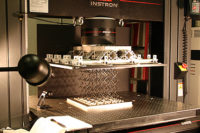Assembler Robots Build Large Structures From Tiny Pieces

CAMBRIDGE, MA—Engineers at the Massachusetts Institute of Technology (MIT) have developed an army of tiny robots that can assemble large lattice structures, such as aircraft fuselages or wings.
“What’s at the heart of this is a new kind of robotics that we call relative robots,” says Neil Gershenfeld, director of MIT’s Center for Bits and Atoms. “Historically, there have been two broad categories of robotics—ones made out of expensive custom components that are carefully optimized for particular applications, such as factory assembly, and ones made from inexpensive mass-produced modules with much lower performance.
“The new robots, however, are an alternative to both,” claims Gershenfeld. “They’re much simpler than the former, while much more capable than the latter, and they have the potential to revolutionize the production of large-scale systems, from airplanes to bridges to entire buildings.”
According to Gershenfeld, the key difference lies in the relationship between the robotic device and the materials that it is handling and manipulating. “With these new kinds of robots, you can’t separate the robot from the structure,” he points out. “They work together as a system.
“For example, while most mobile robots require highly precise navigation systems to keep track of their position, the new assembler robots only need to keep track of where they are in relation to the small subunits, called voxels, that they are currently working on,” explains Gershenfeld. “Every time the robot takes a step onto the next voxel, it readjusts its sense of position, always in relation to the specific components that it is standing on at the moment.
“The underlying vision is that just as the most complex of images can be reproduced by using an array of pixels on a screen, virtually any physical object can be recreated as an array of smaller three-dimensional pieces (voxels), which can themselves be made up of simple struts and nodes,” adds Gershenfeld.
Gershenfeld and his colleagues have discovered that these components can be arranged to distribute loads efficiently. They are largely made up of open space so that the overall weight of the structure is minimized. The units can be picked up and placed in position next to one another by the simple assemblers, and then fastened together using latching systems built into each voxel.
The robots themselves resemble a small arm, with two long segments that are hinged in the middle, and devices for clamping onto the voxel structures on each end. The devices move around like inchworms, advancing along a row of voxels by repeatedly opening and closing their V-shaped bodies to move from one to the next.
As it works on assembling the pieces, each of the tiny robots can count its steps over the structure. Along with navigation, this lets the robots correct errors at each step, eliminating most of the complexity of typical robotic systems.
“It’s missing most of the usual control systems, but as long as [the robot] doesn’t miss a step, it knows where it is,” says Gershenfeld. “For practical assembly applications, swarms of such units could be working together to speed up the process.
“One advantage of such assembly is that repairs and maintenance can be handled easily by the same kind of robotic process as the initial assembly,” claims Gershenfeld. “Damaged sections can be disassembled from the structure and replaced with new ones, producing a structure that is just as robust as the original. This process can also be used to make modifications or improvements to the system over time.”
Looking for a reprint of this article?
From high-res PDFs to custom plaques, order your copy today!



